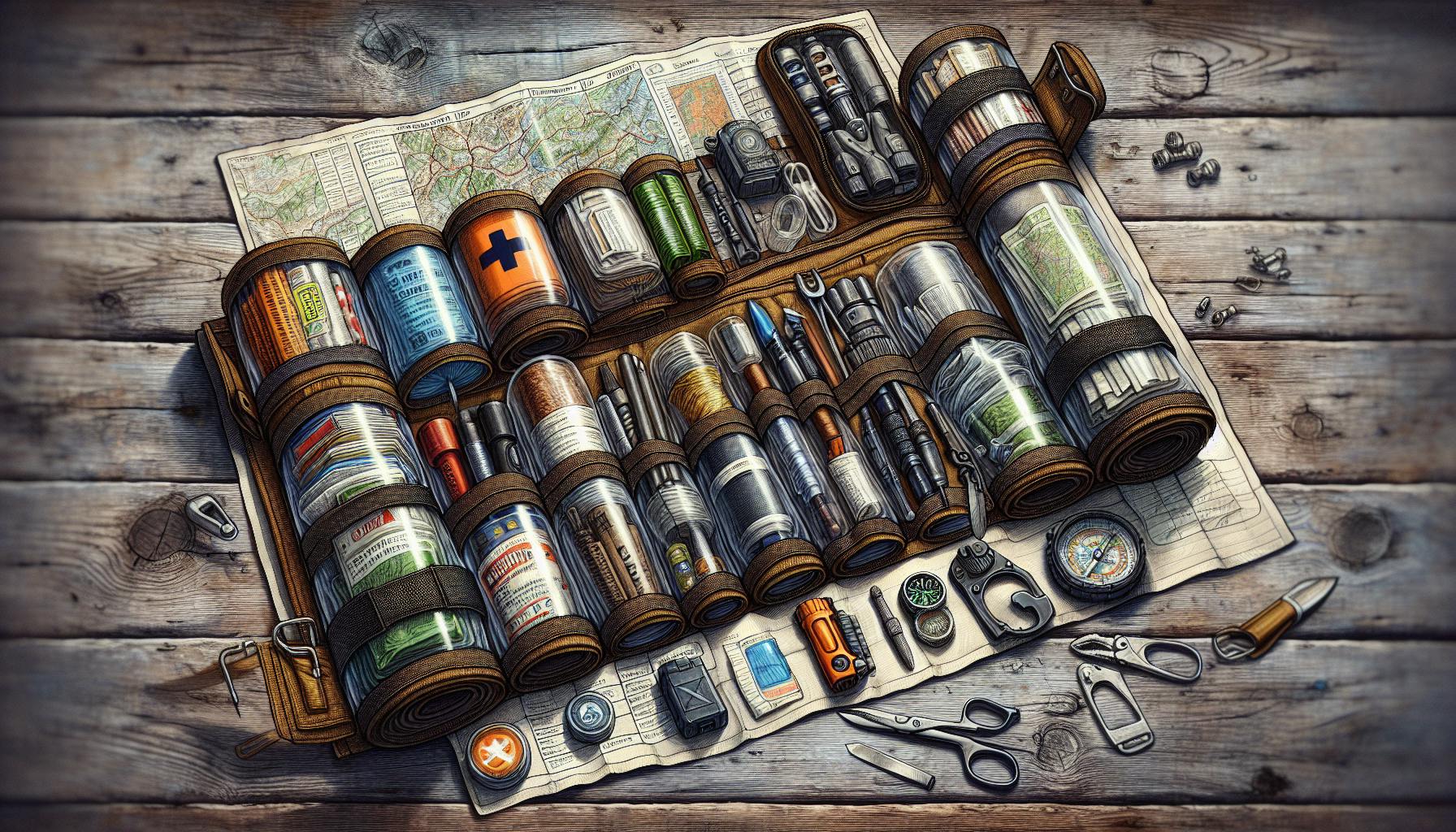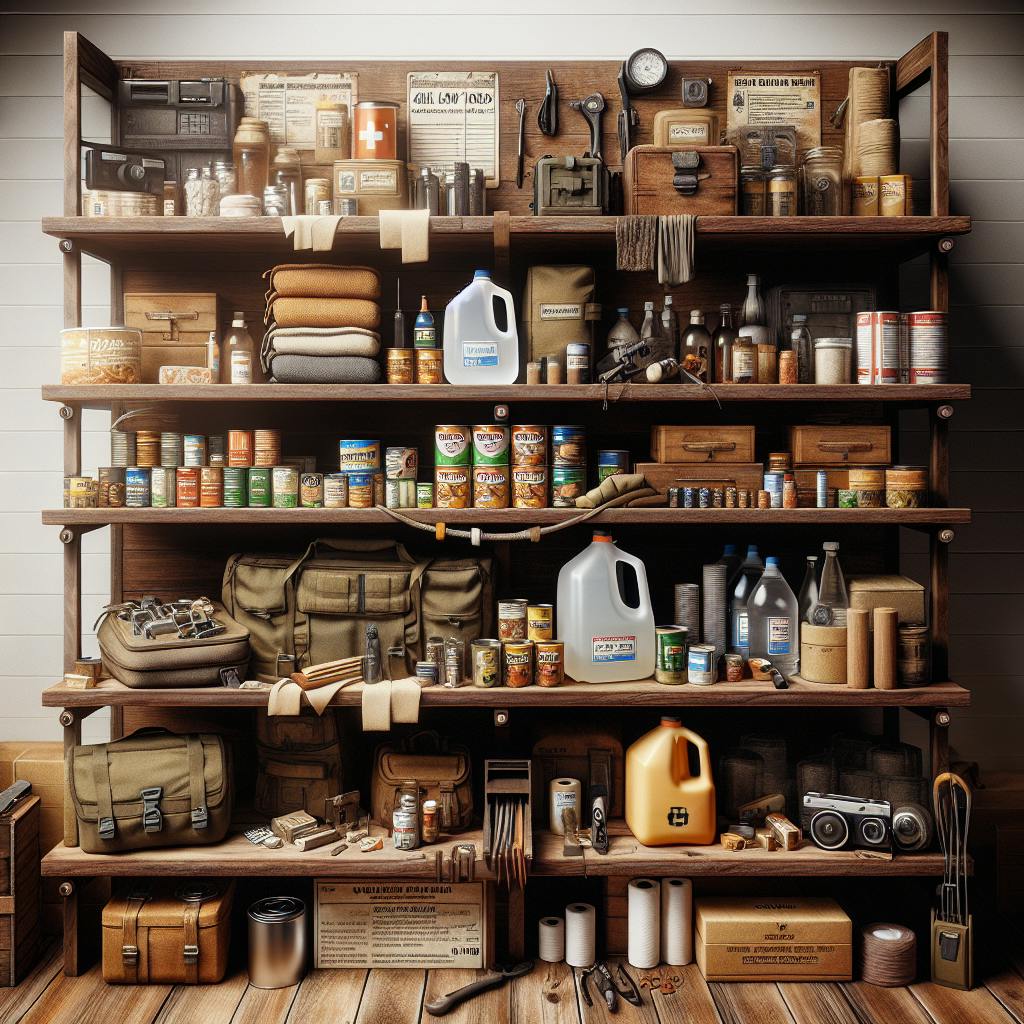Introduction: The Basics of Prepper Stockpiling
Preparing for emergencies by stockpiling supplies is a key practice for many preppers. Having reserves of food, water, medical items, and other critical gear can provide sustenance and security when unexpected disasters strike. When getting started, it's important to focus on affordable, long-lasting choices and avoid some common rookie mistakes. The main categories of essentials that most preppers stockpile include food, water, first aid supplies, tools, weapons, clothing, shelter items, and sanitation/hygiene products. Gradually building your stockpile overtime allows you to spread out costs and ensure you have adequate reserves tailored to your situation. Resources like WeLovePrepping.com provide valuable information to research and customize your stockpile.
Food and Water Reserves
The top priorities are food and water, as these are basic to survival. Many preppers stockpile several months' to years' worth of supplies.
-
Canned goods, such as beans, tuna, and vegetables, dehydrated/freeze-dried meals like Mountain House, rice, pasta, wheat berries are inexpensive, calorie-dense, and boast long shelf lives up to 25 years. Consider nutritional balance and dietary needs too.
-
Bottled water should be rotated every 6 months. Storing water in 55-gallon plastic drums with water preservatives added allows for long-term reserves. Portable water filters, chemicals, and boiling tools provide options for purifying water from natural sources.
-
Seeds allow for growing food after a disaster. Honey, spices, vitamins, and comfort foods like candy bars or powdered drinks help provide nutrition and morale. Don't forget pet food either!
-
Monitor expiration dates closely. Use the FIFO (first-in, first-out) method to rotate stock.
First Aid Supplies
Medical emergencies can arise anytime, so having reserves of first aid gear is critical.
-
Stock various bandages, gauze, medical tape, splints, sutures, trauma shears, and other basic supplies for treating wounds. Antibiotic ointments are also essential.
-
Store prescription medications, pain relievers like ibuprofen, antibiotics, burn cream, allergy meds, etc. Reference detailed first aid manuals for medical procedures.
-
Consider surgical instruments like scalpels, clamps, and sterilization supplies for more advanced treatment, especially in prolonged situations without access to doctors.
Tools and Weapons
Reliable tools and defensive items help secure your situation, construct shelters, hunt/fish, farm, and repair things.
-
Multi-tools, axes, saws, shovels, ropes, and work gloves enable constructing shelter and gathering resources.
-
LED flashlights, batteries, battery powered lanterns, and hand-crank radios provide light and communications. Pepper spray, night-vision gear, and two-way radios also useful.
-
Quality knives, firearms, bows/arrows, slingshots facilitate hunting and defense. Stock ammo and get firearm training/practice.
Clothing and Shelter
Having adequate clothing, blankets, tents, and other gear to establish safe shelter from the elements can mean the difference between life or death after a disaster.
-
Pack clothes appropriate for seasonal weather, including outerwear, hats, gloves, and sturdy boots. Wool socks retain warmth when wet.
-
Durable tents, heavy-duty tarps, sleeping bags, blankets provide portable shelter. Waterproof and insulated qualities are key.
-
A sewing kit allows repairing and making new clothes. Store extra fabric, thread, needles, and scissors.
Hygiene and Sanitation
Maintaining cleanliness and health is crucial when living off grid without plumbing or medical facilities nearby.
-
Stock soaps, toothpaste, toilet paper, diapers, feminine products. Rotate out toiletries before expiration.
-
Disinfectants, bleach, heavy-duty gloves, waste disposal tools like shovels and buckets safely contain illness-causing bacteria.
-
Towels, grooming supplies like razors, combs, nail clippers, tweezers boost morale and health.
Key Planning Factors for Stockpiling
Careful planning and preparation enables creating a well-rounded, long-lasting stockpile tailored to your situation. Here are some key factors to consider:
-
First, determine the duration you aim to be self-reliant - weeks, months, years? This helps gauge amounts needed.
-
Assess available space for storage and organization. Shelving units or plastic totes help maximize it.
-
Make lists of critical items based on climate, season, skills, health needs, and intended duration of stockpile.
-
Research optimal storage methods and shelf lives of items. Budget wisely and buy in bulk when possible.
Stock Up Gradually Over Time
Building your reserves incrementally over weeks and months is often easier on the wallet than buying everything at once.
-
Start with highest priority items, then add to your inventory week-by-week. Take advantage of sales and discounts.
-
Dollar-cost average purchases over time rather than spending large lump sums all at once.
-
When grocery shopping, pick up a few extra canned goods or bags of rice each trip to build your stockpile steadily.
-
Use the FIFO inventory method to avoid waste - older supplies get used first.
Store Items Properly for Maximum Shelf Life
Proper storage goes a long way towards ensuring your stockpile lasts as long as intended.
-
Seal food in Mylar bags with oxygen absorbers or food-grade plastic buckets for an airtight environment.
-
Store in cool, dry, dark conditions to maximize shelf life. Avoid temperature extremes.
-
Designate an area just for your stockpile. Use sturdy shelving, crates, storage totes to organize.
-
Label everything clearly with contents and date. Keep detailed inventory lists.
Have Contingency Plans Ready
Being prepared for the unpredictable is key to handling emergency situations well.
-
Have backup locations like relatives' homes for extra storage and evacuation plans ready.
-
Test living solely off your stockpile to identify gaps before an actual emergency.
-
Maintain an inventory list to track usage and adjust purchasing priorities accordingly.
-
Always keep bug out bags stocked and ready in case quick evacuation becomes necessary.
Maintain OPSEC and Be Discreet
Avoid drawing unnecessary attention or scrutiny when building your stockpile.
-
Keep a low profile. Don't advertise your preps. Vet any groups/communities thoroughly before joining.
-
Discreetly acquire supplies over time. Have a cover story for purchases if questioned.
-
Hide and secure your stockpile from prying eyes. Tell only trusted loved ones.
Special Considerations for Apartment Dwellers
Limited space needn't prevent apartment dwellers from keeping an emergency stockpile.
-
Opt for under-bed storage containers and vertical stacking plastic totes to maximize space.
-
Prioritize compact, essential items like first aid kits, flashlights, and hygiene supplies.
-
Stick to basic 1-2 month water and food reserves suitable for your space.
-
Ask trusted friends/family if you can store some supplies in their home.
-
Consider a small, inconspicuous offsite storage unit for extra reserves if needed.
Critical Categories for Every Stockpile
While each prepper's supplies differ based on needs and scenarios, several key categories warrant inclusion in most well-rounded stockpiles.
-
Cover basics like water, long-lasting food, first aid, hygiene first. Shelter, clothing, self-defense also vital.
-
Add medications, pet food, specialty items to meet your family's needs.
-
Fuel, lighting, comms equipment, barter goods help in prolonged situations.
-
Research and customize - let your skills, climate, timetable, and needs guide choices.
Water - Stored and Purification
Living 3 days without water is difficult, so having adequate water stores is a top priority.
-
Store at least 1+ gallon per person daily, with a minimum 2 week supply as a starting point.
-
Rotate bottled water every 6 months. Store in cool, dark place.
-
55-gallon drums with water preservatives allow safe long-term bulk reserves.
-
Portable filters, chemicals, boiling tools enable purifying found water sources.
Long Shelf-Life Food
Stockpile calorie-dense staples with decades-long expiration dates.
-
Rice, beans, pasta, wheat - inexpensive, versatile food reserves.
-
Canned meat, fruits, vegetables can last 2+ years safely when unopened.
-
Dried foods like jerky, nuts, protein bars, dehydrated meals are lightweight and stable.
-
Oils, spices, supplements provide needed calories, nutrition, and variety.
First Aid
Medical issues can rapidly become life-threatening without professional care nearby.
-
Adhesive bandages, gauze rolls, wraps, splints, sutures, shears, thermometers.
-
Antibiotics, prescription meds, ibuprofen, aloe, benzoin, tape, sterile gloves.
-
Surgical tools, wound closure strips, clamps, scalpels, sterilization supplies.
-
Detailed medical references like survival manuals and emergency field guides.
Sanitation and Hygiene
Preventing illness is crucial when living off-grid without plumbing or doctors.
-
Stock soaps, toothpaste, toilet paper, diapers, feminine products, shampoo.
-
Disinfectants, bleach, heavy gloves, trash bags, buckets safely contain bacteria.
-
Towels, nail clippers, combs, tweezers, razors for cleanliness and health.
Lighting
Reliable light provides security and enables tasks after dark.
-
LED flashlights/lanterns with spare batteries or solar/crank charging last long without battery changes.
-
Candles, matches, lighters are low-tech backup sources of light.
-
Headlamps free up hands for tasks like medical care or repairs at night.
Final Thoughts
Planning and stocking up on the essentials listed here will help you be as prepared as possible when facing emergencies. Tailor your stockpile to your situation. Rotate and replenish items over time. With wise preparation, you can have confidence and peace of mind knowing you and your loved ones will be able to safely weather whatever comes your way. Stay safe out there!


